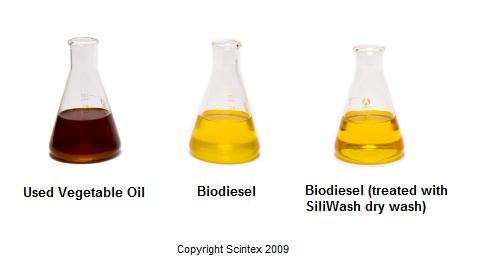Biodiesel Information - An Alternative Fuel to Petro Diesel
Biodiesel is an organic fuel which is very similar in properties to normal diesel. It consists of methyl or ethyl esters, depending on whether methanol or ethanol is used in the production process. Biodiesel can be made from plant oils including straight vegetable oil or used/waste vegetable oil (UVO/WVO) and even animal fats or tallow.
Environmental and Cost Advantages
Biodiesel burns with up to 70% less emissions and is also produced from renewable resources giving it several advantages over petro diesel. Large cost savings can also be achieved particularly when used vegetable oil is converted to biodiesel, with the end product costing as little as 25 cents a litre. Using plant oils and animal fats can also produce cost effective biodiesel but the feasibility depends heavily on the cost of these oils and the price of crude oil. In recent times with the cost of crude oil sky rocketing biodiesel has become an economical way of generating a usable source of energy. There are critics of biodiesel production as it uses land and resources which could have been used to produce food. The emission reducing effects of biodiesel is also under debate as the growing of biodiesel feed stocks adds to the total emissions for the fuel. However, there is no debating that biodiesel produced from WVO remains a very cost effective and environmentally friendly fuel alternative.
Biodiesel vs Petro-diesel
Biodiesel is popular as it is very similar in properties to normal diesel. This means there is very little if any vehicle modification necessary to use biodiesel. One big difference between the two fuels is biodiesel has a higher cloud point and pour point. In colder climates this can lead to a thicker fuel and clogged fuel filters and injectors. The cloud point for biodiesel will depend on the feed stock used as well as whether methyl or ethyl alcohol was used in production. Methanol will have a lower cloud point than ethanol as it reduces the molecular weight of the resultant biodiesel esters. The types of triglycerides in the feed stock oil also change the cloud point. Tallow generally has higher molecular weight glycerides and produces biodiesel with a relatively high cloud point of up to 10oC, whereas canola oil will lead to biodiesel with a lower cloud point around -10oC. Biodiesel tends to go off faster than normal diesel and may require pre-blending of the fuel for storage or use of biocide products. These problems with biodiesel can be avoided or reduced by using blends with petro-diesel and is common practice in the fuel industry. Biodiesel offers an advantage over petro-diesel as it tends to have better lubrication properties and can reduce wear on engine fuel components such as fuel injectors and fuel pumps.
Biodiesel Production Process
Biodiesel is made through the transesterification of triglyceride molecules found in plant or animal oils. Using a base catalyst (potassium hydroxide or sodium hydroxide), an alcohol usually methanol or ethanol and heat (55°C) the triglyceride is converted to 3 ester molecules. The reaction can be seen below. It is this reduction in molecular weight that changes the viscosity, volatility and other properties of the original oil.

The resultant Methyl esters are hydrophobic in nature and the glycerol is significantly more hydrophilic. Thus, the methyl esters and glycerol form distinct layers which can easily be separated. This is extremely convenient and is the main reason behind the simplicity of biodiesel production. Biodiesel can be further refined by washing with water. This will further remove water soluble impurities, such as soaps, methanol, potassium, sodium and hydroxide ions, that did not separate out in the initial glycerol layer. While water washing is common and cost effective it is essentially introducing another impurity to your biodiesel, water. Many biodiesel producers now utilise dry washing techniques. This involves using a solid media, often silicate solids, to filter out impurities. The silicates which exist in near ionic form work similar to water washing as you are introducing a hydrophilic substrate which will preferentially absorb water soluble impurities from your biodiesel. Dry washing offers a key advantage over water washing as it can easily be removed from your biodiesel by filtration.
Side Note: The biodiesel reaction is very sensitive to water content. If water is present in the reaction mixture the triglycerides and esters can be hydrolysed (with base catalyst) to form long chain carboxylic acids or free fatty acids (FFAs). See below. When present in a basic solution FFAs are also known as carboxylic acid salts or soaps. The presence of soap in your biodiesel will cause problems when trying to water wash, as well as reducing conversion of your oil and are another impurity that needs to be removed.



